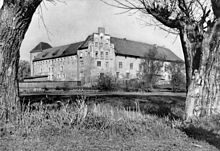Treaty of Labiau
The Treaty of Labiau was on the castle Labiau during the Second Northern War on 20th November 1656 between the Elector Friedrich Wilhelm of Brandenburg , who in personal union was also Duke of Prussia, and King Charles X Gustav of Sweden closed. It was the result of the Battle of Warsaw , in which the Swedes and Brandenburgers, allied in the Treaty of Marienburg , had defeated Poland-Lithuania in June 1656 .
With the Labiau Treaty, the Swedish feudal sovereignty over the Duchy of Prussia , which Karl Gustav had forcibly obtained in January 1656 through the Treaty of Königsberg , ended. Now he recognized the elector as “the highest, absolute and sovereign prince in Prussia and Warmia ”. In the expected peace with Poland, Sweden was to receive the Polish Prussian royal share , furthermore the Duchy of Courland and Zemgallia , the Lithuanian Duchy of Samogitia and Polish Livonia and, if necessary, the Elector should move to Polish territories, which Sweden had promised him in the Marienburg Treaty, dispense.
However, the elector was not interested in a decision to go to war because he lacked recognition by Poland for full sovereignty in Prussia. Friedrich Wilhelm began secret negotiations with the enemy. The result was the treaties of Wehlau and Bromberg with the recognition of its sovereignty by Poland, which was now allied with it.
The Treaty of Oliva , which ended the war in 1660, canceled the Treaty of Labiau in Article 25, as well as the Treaties of Königsberg and Marienburg.
Course of development towards the sovereignty of Prussia
- January 17, 1656 Treaty of Königsberg
- June 23, 1656 Treaty of Marienburg
- 28-30 June 1656 Battle of Warsaw
- November 20, 1656 Treaty of Labiau
- September 19, 1657 Treaty of Wehlau
- November 6, 1657 Treaty of Bromberg
- May 3, 1660 Treaty of Oliva
Web links
Individual evidence
- ^ Contents of the alliance treaty and the secret articles on the peace treaty in Theodor von Moerner: Kurbrandenburgs state contracts from 1601 to 1700 . G. Reimer, Berlin 1867 (Google eBook)
- ↑ Helmuth Rönnefarth: conferences and treaties. Contract Ploetz, a handbook of historically significant meetings, agreements, manifestos and memoranda. Part II: 1493-1952. AG Ploetz, Bielefeld 1953, p. 29

